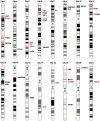Chinese Society of Allergy Guidelines for Diagnosis and Treatment of Allergic Rhinitis
- PMID: 29949830
- PMCID: PMC6021586
- DOI: 10.4168/aair.2018.10.4.300
Chinese Society of Allergy Guidelines for Diagnosis and Treatment of Allergic Rhinitis
Abstract
Allergic rhinitis (AR) is a global health problem that causes major illnesses and disabilities worldwide. Epidemiologic studies have demonstrated that the prevalence of AR has increased progressively over the last few decades in more developed countries and currently affects up to 40% of the population worldwide. Likewise, a rising trend of AR has also been observed over the last 2-3 decades in developing countries including China, with the prevalence of AR varying widely in these countries. A survey of self-reported AR over a 6-year period in the general Chinese adult population reported that the standardized prevalence of adult AR increased from 11.1% in 2005 to 17.6% in 2011. An increasing number of Journal Articles and imporclinical trials on the epidemiology, pathophysiologic mechanisms, diagnosis, management and comorbidities of AR in Chinese subjects have been published in international peer-reviewed journals over the past 2 decades, and substantially added to our understanding of this disease as a global problem. Although guidelines for the diagnosis and treatment of AR in Chinese subjects have also been published, they have not been translated into English and therefore not generally accessible for reference to non-Chinese speaking international medical communities. Moreover, methods for the diagnosis and treatment of AR in China have not been standardized entirely and some patients are still treated according to regional preferences. Thus, the present guidelines have been developed by the Chinese Society of Allergy to be accessible to both national and international medical communities involved in the management of AR patients. These guidelines have been prepared in line with existing international guidelines to provide evidence-based recommendations for the diagnosis and management of AR in China.
Keywords: Allergic rhinitis; China; diagnosis; treatment.
Copyright © 2018 The Korean Academy of Asthma, Allergy and Clinical Immunology · The Korean Academy of Pediatric Allergy and Respiratory Disease.
Figures

















References
-
- Bousquet J, Van Cauwenberge P, Khaltaev N Aria Workshop Group; World Health Organization. Allergic rhinitis and its impact on asthma. J Allergy Clin Immunol. 2001;108:S147–S334. - PubMed
-
- Brozek JL, Bousquet J, Baena-Cagnani CE, Bonini S, Canonica GW, Casale TB, et al. Allergic Rhinitis and its Impact on Asthma (ARIA) guidelines: 2010 revision. J Allergy Clin Immunol. 2010;126:466–476. - PubMed
-
- Roberts G, Xatzipsalti M, Borrego LM, Custovic A, Halken S, Hellings PW, et al. Paediatric rhinitis: position paper of the European Academy of Allergy and Clinical Immunology. Allergy. 2013;68:1102–1116. - PubMed
-
- Seidman MD, Gurgel RK, Lin SY, Schwartz SR, Baroody FM, Bonner JR, et al. Clinical practice guideline: allergic rhinitis. Otolaryngol Head Neck Surg. 2015;152:S1–S43. - PubMed
-
- Ellis AK, Soliman M, Steacy L, Boulay ME, Boulet LP, Keith PK, et al. The Allergic Rhinitis - Clinical Investigator Collaborative (AR-CIC): nasal allergen challenge protocol optimization for studying AR pathophysiology and evaluating novel therapies. Allergy Asthma Clin Immunol. 2015;11:16. - PMC - PubMed
Publication types
LinkOut - more resources
Full Text Sources
Other Literature Sources
Medical
Research Materials
Miscellaneous

